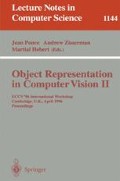Abstract
We measured pictorial relief for a series of pictures of a smooth solid object. The scene was geometrically identical (i.e., the perspective of the same 3D scene) for all pictures, the rendering different. Some of the pictures were monochrome full scale photographs taken under different illuminations of the scene. We also included a silhouette (uniform black on uniform white) and a “cartoon” style rendering (visual contour and key linear features rendered in thin black line on a uniform white ground). Two subjects were naive and started with the silhouette, next did the cartoon, finally the full scale photographs. Another subject had seen the object and did the experiment in the opposite sequence. The silhouette rendering is impoverished,but has considerable relief with much of the basic shape. The cartoon rendering yields well developed pictorial relief, even in the naive subjects. Shading adds only small local details, but different illuminations produce significant alterations of relief. We conclude that shape constancy under changes in illumination rules throughout, but that the (small) deviations from true constancy reveal the effect of cues such as shading in a natural setting. Such a “perturbation analysis” appears more promising than either stimulus reduction or cue conflict paradigms.
An earlier version of this paper was published in Perception, volume 5, 1996. This paper is included in this volume by kind permission of Pion Ltd. Jan Koenderink is supported by the Human Frontiers Science Program. Andrea van Doorn is supported by the Netherlands Organization for Scientific Research (NWO). Chris Christou is supported by the ESPRIT Basic Research Action INSIGHT of the European Commission. Joe Lappin visited Utrecht for two months and was supported by the Human Frontiers Science Program.
Preview
Unable to display preview. Download preview PDF.
References
Bülthoff H B, Mallot H O, 1988 “Integration of depth modules: stereo and shading” J.Opt.Soc.Am. A5 1749–1757
Clifton J, 1973 The eye of the artist (Westport, Conn.: North Light Publishers)
Erens R G F, Kappers A M L, Koenderink J J, 1991 “Limits on the perception of local shape from shading”, in Studies in Perception and Action Eds P J Beek, R J Bootsma, P C W van Wieringen (Amsterdam) pp. 65–71
Erens R G F, Kappers A M L, Koenderink J J, 1993a “Perception of local shape from shading” Perception & Psychophysics 54 (2) 145–156
Erens R G F, Kappers A M L, Koenderink J J, 1993b “Estimating local shape from shading in the presence of global shading” Perception & Psychophysics 54 (3) 334–342
Adams R M, 1974 The roman stamp. Frame and facade in some forms of neo-classicism (Berkeley: University of California Press)
Gombrich E H, 1982 The image and the eye, further studies in the psychology of pictorial representation (Oxford: Phaidon)
Hale N C, 1980 Abstraction in Art and Nature (New York: Watson-Guptill)
Hattersley R, 1979 Photographic lighting, learning to see (Englewood Cliffs, New Jersey: Prentice-Hall, Inc.)
Hogarth B, 1981 Dynamic light and shade (New York: Watson-Guptill)
Hunter F, Fuqua P Light, Science and Magic, an introduction to photographic lighting (Boston: Focal Press)
Jacobs T S, 1988 Light for the artist (New York: Watson-Guptill)
Johnston E E, 1991 “Systematic distortions of shape from stereopsis” Vis.Res. 31 1351–1360
Koenderink J J, Doorn A J van, 1995 “Relief: Pictorial and otherwise” Image and Vision Computing 13 (5) 321–334
Koenderink J J, Doorn A J van, Kappers A M L, 1992 “Surface perception in pictures” Perception and Psychophysics 32 487–496
Koenderink J J, Doorn A J van, Kappers A M L, 1994 “On so-called paradoxical monocular stereoscopy” Perception 23 583–594
Lomazzo P, 1958, in: A documentary history of art Vol.II, Ed. E G Holt (Garden City, New York: Doubleday)
Nurnberg W, 1948 Lighting for portraiture (London: The Focal Press)
Pirenne M H, 1970 Optics, Painting and photography (Cambridge: Cambridge University Press)
Ramachandran V, 1988 “Shape from shading” Nature 331 Januari 14th
Schöne W, 1954 Über das Licht in der Malerei (Berlin: Gebr.Mann Verlag)
Todd J J, Akerstrom R A, 1987 JEP: Human Perc. and Performance 13(2) 242–255
Truxal J G, 1955 Automatic feedback control system synthesis (New York: McGraw-Hill)
Author information
Authors and Affiliations
Editor information
Rights and permissions
Copyright information
© 1996 Springer-Verlag Berlin Heidelberg
About this paper
Cite this paper
Koenderink, J.J., van Doorn, A.J., Christou, C., Lappin, J.S. (1996). Shape constancy in pictorial relief. In: Ponce, J., Zisserman, A., Hebert, M. (eds) Object Representation in Computer Vision II. ORCV 1996. Lecture Notes in Computer Science, vol 1144. Springer, Berlin, Heidelberg. https://doi.org/10.1007/3-540-61750-7_27
Download citation
DOI: https://doi.org/10.1007/3-540-61750-7_27
Published:
Publisher Name: Springer, Berlin, Heidelberg
Print ISBN: 978-3-540-61750-1
Online ISBN: 978-3-540-70673-1
eBook Packages: Springer Book Archive

